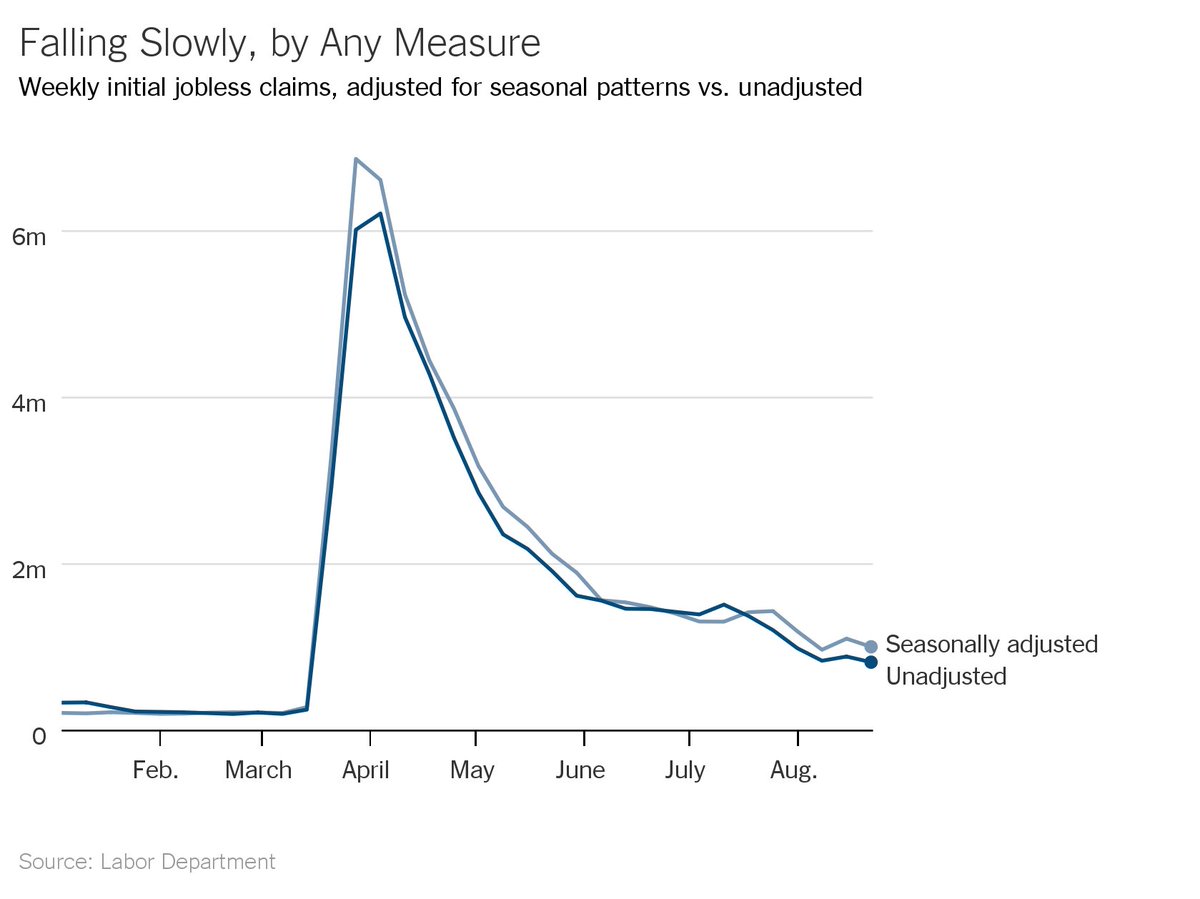IMPORTANT NOTE: Starting this week, the Labor Department will be changing its approach to seasonal adjustment for weekly unemployment claims. And the Times will be changing the way we report the numbers, too. https://www.nytimes.com/live/2020/09/01/business/stock-market-today-coronavirus/the-labor-department-will-start-counting-unemployment-claims-in-a-new-way">https://www.nytimes.com/live/2020...
Long, nerdy thread to follow. But first the key points:
- This change should make the seasonally adjusted numbers more accurate
- DOL is not revising prior data, which means the new SA numbers WILL NOT BE COMPARABLE to the old ones
- If you want to compare over time, use NSA data
- This change should make the seasonally adjusted numbers more accurate
- DOL is not revising prior data, which means the new SA numbers WILL NOT BE COMPARABLE to the old ones
- If you want to compare over time, use NSA data
OK, now for the nerdy details. Feel free to mute this thread if you aren& #39;t interested. I promise not to be offended.
Our story on this is here: https://www.nytimes.com/live/2020/09/01/business/stock-market-today-coronavirus/the-labor-department-will-start-counting-unemployment-claims-in-a-new-way">https://www.nytimes.com/live/2020...
Our story on this is here: https://www.nytimes.com/live/2020/09/01/business/stock-market-today-coronavirus/the-labor-department-will-start-counting-unemployment-claims-in-a-new-way">https://www.nytimes.com/live/2020...
Seasonal adjustment is meant to account for regular, predictable patterns in layoffs. Take the first week of June, for example: Every year, jobless claims spike that week, not because of an impending recession but because thousands of public school employees get laid off
The seasonal adjustment formula "knows" this, and expects claims to rise ~15% the first week of June each year. An increase < 15% will show up as a drop in claims. A bigger jump will show up as an increase in claims, but a smaller one than we see in the unadjusted data.
Last year, for example, claims rose by about 30,000 that week, which was almost exactly what historical patterns would predict. So the Labor Department reported *no change* in seasonally adjusted claims.
This year, though, the absolute level of claims is WAY higher than normal because of the pandemic. So the formula once again expected claims to rise ~15%, but now 15% would be nearly 250,000 claims!
As it happens, unadjusted filings *fell* by about 60k that week this year. The formula, expecting a huge increase, reported a 330,000-person drop in seasonally adjusted claims.
But that& #39;s crazy. In the real world, there was no reason to expect a 250k increase in claims that week.
But that& #39;s crazy. In the real world, there was no reason to expect a 250k increase in claims that week.
The new adjustment methodology should fix this. Instead of looking at historical patterns as percentage changes, it will look at actual *levels* of change. So in June, it would have expected an increase of ~30k, and the seasonally adjusted figure would have been around -90k.
Now, even that isn& #39;t perfect. We know that many of the usual school layoffs took place early this year because schools shut down in March/April. The seasonal adjustment formula doesn& #39;t account for that. But at least the new approach doesn& #39;t add tons of extra noise.
So this change is a good thing. Many economists have been calling for something along these lines for months.
But there& #39;s a problem: The Labor Department says it won& #39;t be revising its earlier estimates. It will just switch from one approach to the next mid-stream.
But there& #39;s a problem: The Labor Department says it won& #39;t be revising its earlier estimates. It will just switch from one approach to the next mid-stream.
This means that Thursday& #39;s weekly report will almost certainly show a big drop in claims. But this will be the result of the new methodology, NOT a real-world decline in unemployment filings.
(Note: I& #39;m not 100% clear on whether the standard revision to claims from 8/22 will apply the new or old adjustment method. So it& #39;s possible the big, misleading drop will show up a week earlier. I& #39;ve asked @USDOL and will update if I learn more.)
As a result, the Times plans to emphasize the NON-seasonally adjusted figures on Thursday, and going forward for the foreseeable future. Those numbers won& #39;t be affected by the change, and will be comparable over time.
Many economists have been using NSA data on claims all along b/c of these issues and the way the pandemic has messed with seasonal patterns more generally. We& #39;ve stuck with SA numbers for consistency, and because that& #39;s what most forecasters use. But this has forced our hand.
I suspect many outlets will continue to use seasonally adjusted data. That& #39;s fine -- the new numbers should be more accurate (and the SA and NSA numbers will probably look more similar going forward).
But it is NOT fine to compare data released using different methodologies. If someone says "seasonally adjusted claims fell by 200k last week," that is almost certainly false.
The good news (for understanding the data, not for the world) is that the big picture is the same by any measure. Both SA and NSA data show a huge spike in claims in March/April, a much more gradual decline, and a recent stalling out. </end>
UPDATE: No sooner did I hit "tweet" but @USDOL got back to me on the question about revisions. Initial claims for 8/22 will NOT be revised to reflect the new adjustment methodology. So we should expect to see a big, artificial drop in claims from 8/22 to 8/29.

 Read on Twitter
Read on Twitter


